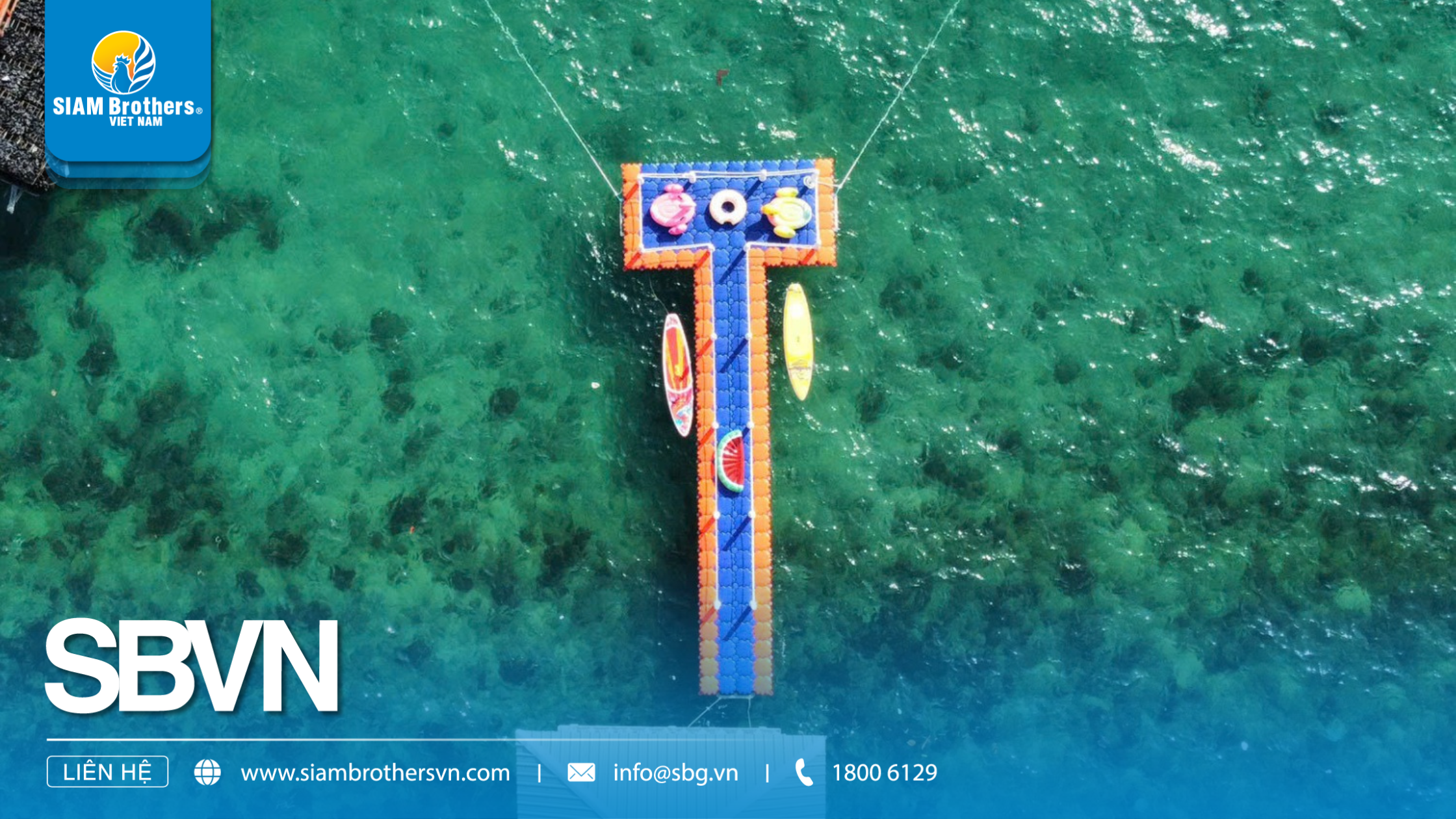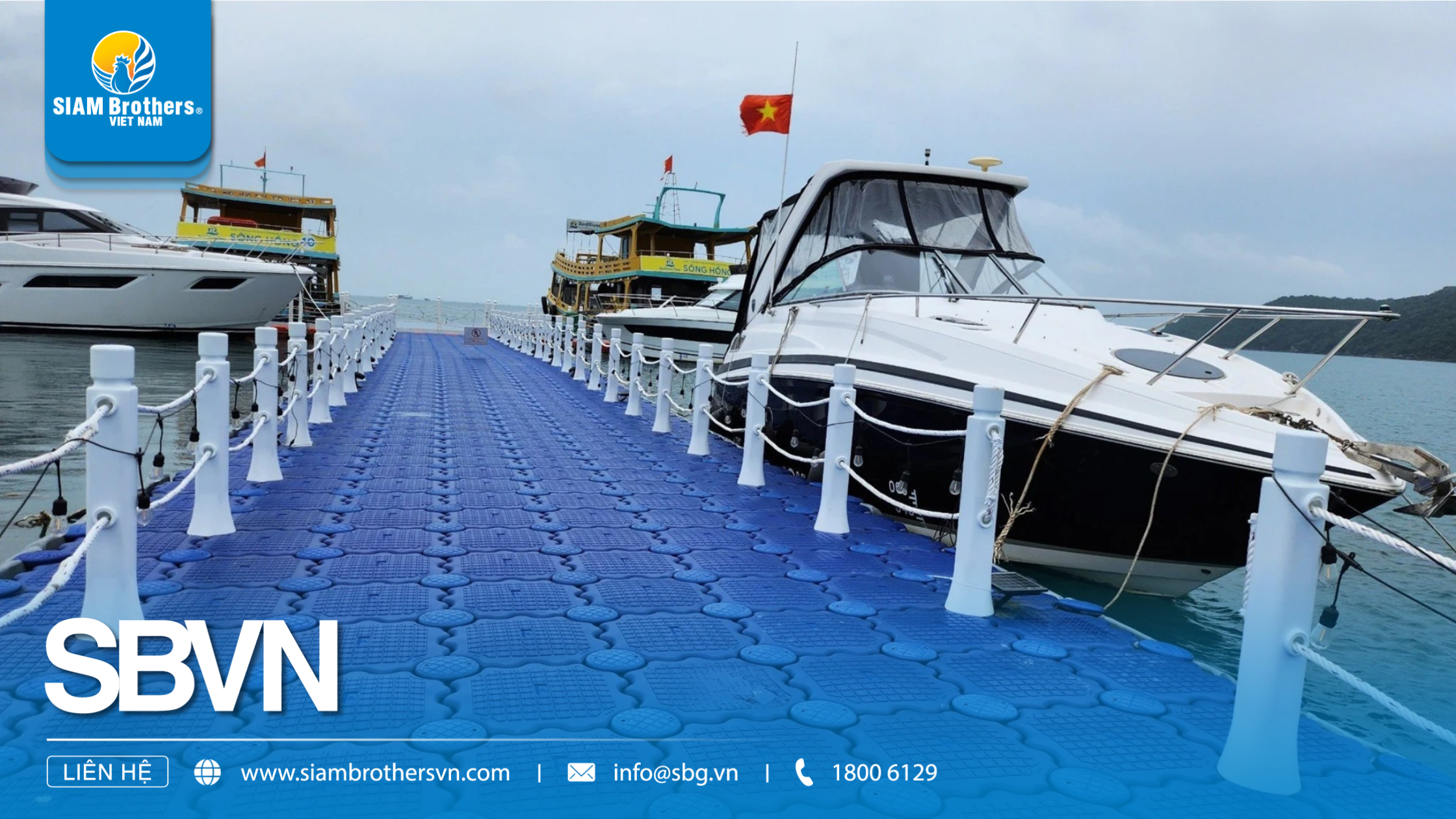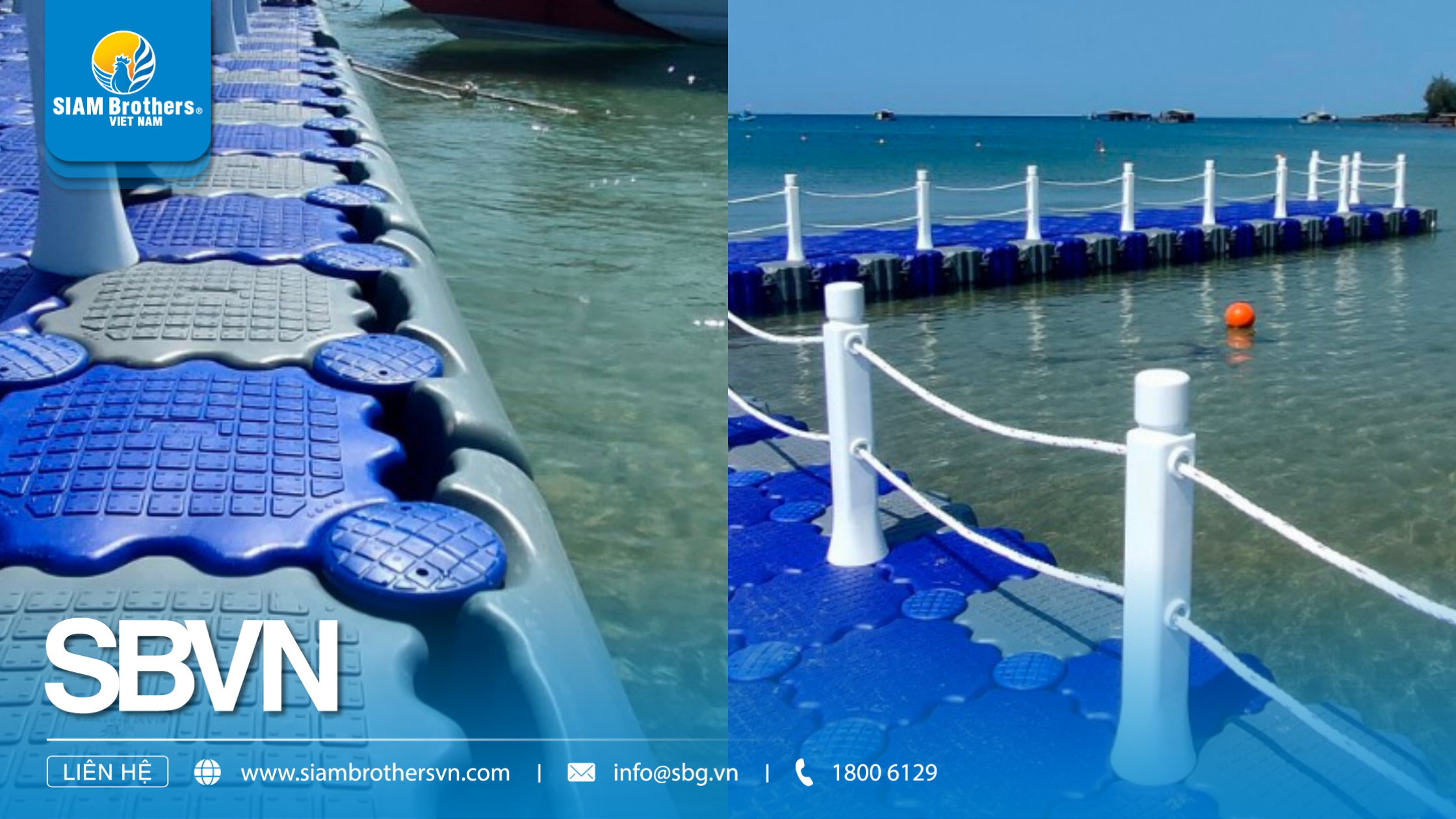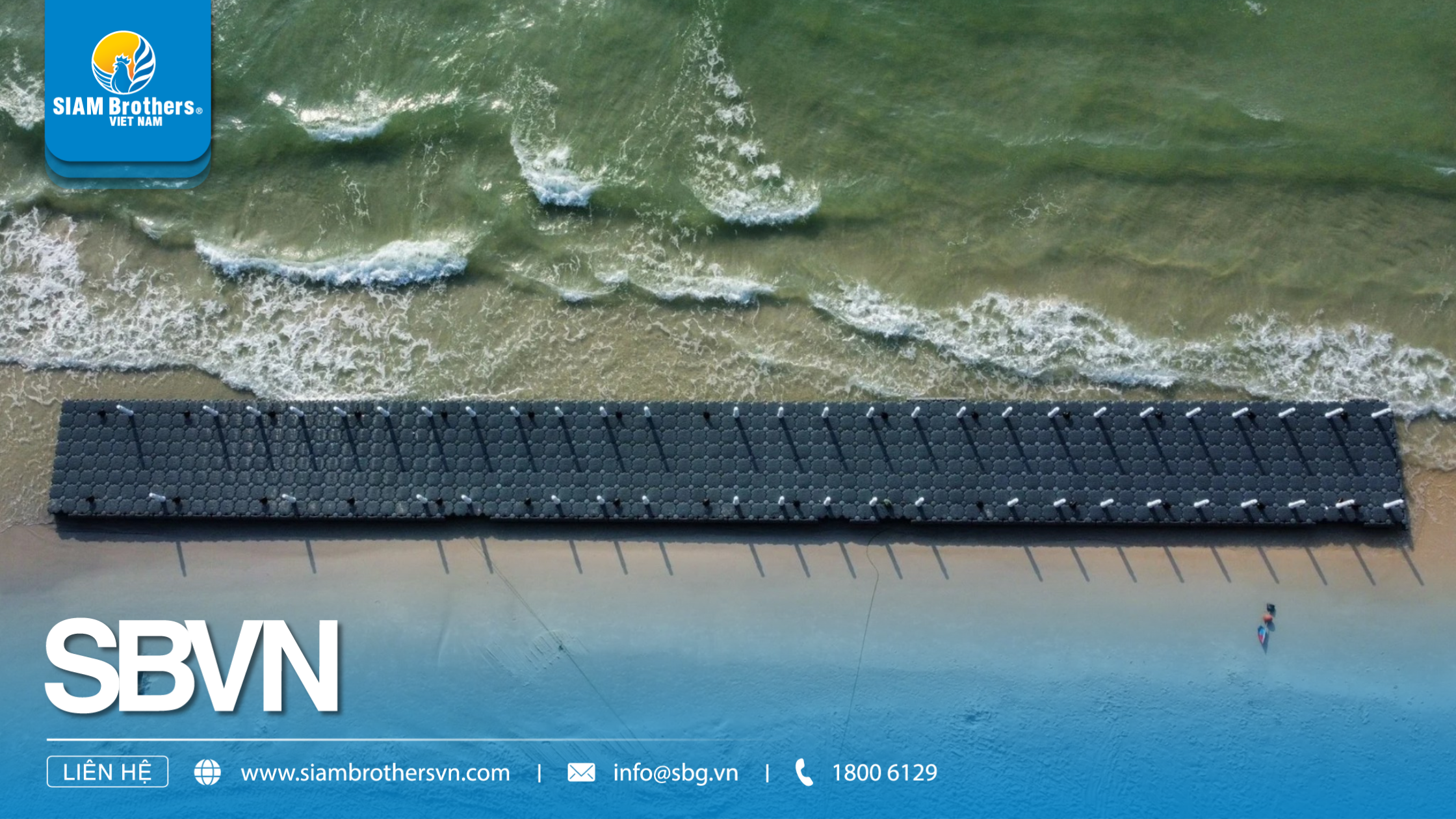Floating Pontoons are becoming an optimal solution for resorts, tourist piers, and boat docks thanks to their flexible modular structure, high safety standards, and compatibility with various water conditions across Vietnam. If you are looking to design a floating walkway that is both durable and enhances the visitor experience, HDPE is the ideal choice due to its strong buoyancy, UV resistance, and stability in rivers, lakes, coastal waters, and brackish environments. In this guide, SIAM Brothers Vietnam explains how to select the right dimensions, load capacity, accessories, and structural layout to ensure safety, cost efficiency, and long-term performance. Explore the full guide to avoid common mistakes during installation.
1. What Are Floating Pontoons? A Safe and Flexible Shore-Connection Solution for Tourism, Leisure, and Light Transport
Floating Pontoons are modular structures made from interlocking HDPE blocks that naturally float on water and are connected using specialized pins or coupling systems. This solution is widely used in resorts, tourist piers, and boat docks because it is easy to assemble, safe to operate, and compatible with many water conditions in Vietnam. Their expandable design also allows investors to optimize water surface use without building permanent foundations.

1.1 Structural Features of HDPE Floating Pontoons
- The structure of HDPE Floating Pontoons is engineered to ensure stability and safety during operation, consisting of:
- HDPE floating modules in square or rectangular form with high load resistance and excellent corrosion resistance.
- Pin joints, bolts, and connectors designed to secure the layout according to the engineering plan.
- Mooring systems using piles or anchor chains to minimize movement caused by wind, waves, or currents.
- Anti-slip deck surfaces to ensure user safety in tourism and recreational environments.
1.2 Applications of Floating Pontoons in Resorts, Tourist Piers, and Boat Docks
- Tourist boat berths for small and mid-sized vessels.
- Walkways connecting the shore to water activities such as SUP, kayak, and jet ski areas.
- Floating pathways for sightseeing, check-in, and waterfront recreational zones.
- Temporary infrastructure for resorts needing seasonal layout adjustments or flexible guest capacity.
1.3 Why HDPE Floating Pontoons Suit Vietnam’s Water Conditions
- Vietnam’s hydrology varies across regions and seasons, making modular pontoons a practical solution thanks to:
- Their ability to adapt to changing water levels, especially in tidal zones.
- Safe performance in calm waters such as bays, major rivers, lakes, and lagoons.
- Strong suitability for coastal tourism areas from Phu Quoc, Nha Trang, and Vung Tau to Can Tho and the Mekong Delta.
2. Benefits of Using HDPE Floating Pontoons for Resorts & Tourist Piers
2.1 Flexibility and Scalable Expansion
- Easy assembly and expansion: HDPE modules can be added or removed depending on seasonal guest capacity.
- Adjustable positioning: Pontoons can be relocated or reoriented based on water level changes or hydrological conditions.
- Suitable for multiple water types: rivers, lakes, lagoons, and coastal resort areas.
2.2 High Safety and Stability
- Strong load capacity: HDPE Floating Pontoons support pedestrian traffic, small golf carts, and light tourism equipment.
- Stable on water: Secure anchoring and interlocking modules prevent excessive movement or tilting under mild waves or currents.
- Anti-slip surface: Ensures safe movement for visitors in wet environments.
2.3 Long Lifespan and Low Maintenance Costs
- Corrosion and UV resistance: Virgin HDPE performs well in brackish and marine environments while enduring strong sunlight.
- Simple maintenance: Routine cleaning and checking of connectors and mooring points are sufficient.
- Lifespan of 10–20 years: Provides long-term cost efficiency.

2.4 Aesthetic Appeal for Tourism Environments
- Modern design: HDPE modules come in various colors that can match resort or pier landscapes.
- Minimal environmental impact: No need for concrete foundations, suitable for ecological or protected areas.
- Enhanced visitor experience: Ideal for scenic walkways, check-in areas, and water-based recreational zones.
2.5 Cost Savings and Fast Installation
- Lower investment cost than fixed structures: No need for heavy concrete foundations or complex construction.
- Rapid installation: Modular assembly reduces construction time from weeks to just a few days.
- Easy relocation or expansion: Minimizes financial risk when adjusting resort or pier layouts.
3. Key Technical Specifications When Choosing HDPE Floating Pontoons
3.1 Pontoon Module Size and Dimensions
- Module dimensions: Common sizes range from 50×50×40 cm to 100×50×40 cm, depending on load requirements and pontoon area.
- HDPE thickness: 3–5 mm for standard modules, ensuring long-term strength and durability.
- Module shape: Square, rectangular, or bar-shaped modules designed for easy assembly and expansion.
3.2 Load Capacity and Buoyancy
- Module buoyancy: Must support the entire pontoon structure, including passengers, light vehicles, and deck coverings.
- Maximum load: 400–600 kg/m² for small tourist areas and 600–800 kg/m² for busy boat docks.
- Module quantity calculation: Determined by pontoon area and expected load to avoid exceeding module limits.
3.3 Mooring and Anchoring Systems
- Mooring options: Pile anchors, chains, or concrete anchors depending on water flow, waves, and water-level changes.
- Anchor spacing: Optimized for stability while allowing movement during tidal fluctuations.
- Anti-drift performance: Ensures the pontoon does not rotate, tilt, or drift during operation.

3.4 Connection Accessories and Decking
- Connectors and bolts: Use corrosion-resistant, high-strength materials for module linking.
- Decking: Anti-slip HDPE or composite wood for safe access for tourists and light vehicles.
- Handrails and guardrails: Enhance safety, especially on long pontoons or docking areas.
3.5 Safety Standards
- Pontoon width: Minimum 1.2–1.5 m for pedestrians; wider for light vehicles.
- Regular load testing: Ensures the pontoon always meets safety standards and prevents overloading during peak hours.
- Anti-slip and anti-tilt design: Secure module connections and suitable deck surfaces for rivers, lakes, and coastal waters in Vietnam.
3.6 Environmental and Site Considerations
- Water level and tides: Design must match local water-level variations to avoid obstruction to boats or visitors.
- Flow and wave conditions: Choose modules and mooring systems that provide stability in strong currents or waves.
- Climate & UV exposure: Virgin HDPE offers UV resistance and withstands heat and saltwater environments.
4. HDPE Floating Pontoon Design Process
4.1 Step 1 – Site Survey and Water Assessment
- Measure water depth and terrain: Determine slope, depth, and tidal range.
- Evaluate currents and waves: Analyze flow speed, wind direction, and wave impact.
- Anchor point identification: Select stable positions for long-term mooring.
4.2 Step 2 – Create the General Design Layout
- Pontoon module arrangement: Define quantity, shape, and connection orientation.
- Pontoon dimensions: Set length and width based on expected traffic and usage.
- Boat access area: Design safe boarding spaces with proper decking and handrails.
4.3 Step 3 – Load Calculation and Buoyancy Analysis
- Define maximum load: Includes passengers, light vehicles, decking, and accessories.
- Calculate module quantity: Ensure adequate buoyancy and stability for real-world usage.
- Safety check: Prevent sinking or tilting under crowd load or light wave conditions.
4.4 Step 4 – Select Materials and Accessories
- Virgin HDPE pontoon modules: Corrosion-resistant, UV-stable, suitable for brackish or marine water.
- High-quality connectors and bolts: Ensure long-term structural stability.
- Decking and railings: Anti-slip surfaces and safety railings compliant with resort and tourism standards.
4.5 Step 5 – Installation and Final Inspection
- Assemble pontoon modules: Follow the approved layout to ensure proper spacing and structural consistency.
- Check anchor systems and balance: Prevent unwanted rotation or movement.
- Safety inspection: Evaluate buoyancy, load capacity, and deck safety before handover.
- Maintenance plan: Regular inspection of connectors, anchors, decking, and HDPE surfaces for optimal lifespan.

5. Real Applications – Floating Pontoon Projects by SIAM Brothers Vietnam
5.1 Floating Pontoon at Bai Khem, Phu Quoc
- Location: Bai Khem – Phu Quoc, one of Vietnam’s most scenic beach destinations.
- Scale: 250 m long and 4 m wide, as specified in the project details.
- Materials: 100% virgin HDPE floating modules manufactured by SIAM Brothers, ensuring exceptional durability and stability.
- Functionality: The pontoon serves as a canoe docking area and a pedestrian walkway, combining aesthetic appeal with high load-bearing capability.
- Technical features: Strong interlocking HDPE pontoon modules with excellent resistance to impact, harsh weather, and coastal conditions.
- Outcome: The Bai Khem Floating Pontoon enhances boat docking operations while maintaining the natural beauty of the beach resort.
5.2 Floating Pontoon at Bai Truong, Phu Quoc
- Location: Bai Truong – the longest beach on Phu Quoc Island.
- Scale: A 50 m long, 3 m wide floating pontoon constructed with approximately 600 HDPE modules supplied by SIAM Brothers.
- Materials: High-quality HDPE offering long-term stability, wave resistance, and durability.
- Flexibility: The modular design enables fast installation, easy relocation, and adjustments based on tourist needs.
- Impact: Beyond serving tourist boats, the Bai Truong Floating Pontoon elevates the overall aesthetics of the area and supports sustainable tourism development.

5.3 HDPE Floating Pontoon at Nam Du Island
- Location: Nam Du Island – a remote but promising marine tourism destination.
- Design: A T-shaped HDPE floating pontoon made from SIAM Brothers’ multipurpose modules, extending into the sea for boats and tourist access.
- Installation speed: Completed in just one day thanks to the highly flexible modular structure.
- Materials: 100% virgin HDPE with strong impact resistance, excellent saltwater tolerance, and superior chemical resistance—ideal for island environments.
- Impact: The project improves essential tourism infrastructure, enhances boat access, and supports increased visitor traffic to Nam Du Island.

6. FAQ – Frequently Asked Questions About HDPE Floating Pontoons
6.1 Can HDPE Floating Pontoons handle heavy loads?
- Load capacity depends on module quantity, pontoon dimensions, and mooring systems.
- SIAM Brothers designs Floating Pontoons to support 400–800 kg/m², suitable for pedestrians, light vehicles, and tourism equipment.
- Custom load calculations can be provided to meet specific project requirements.
6.2 How long does it take to install a Floating Pontoon?
Installation is significantly faster than traditional concrete structures due to the modular HDPE design.
For example:
- The Nam Du pontoon was completed in 1 day.
- The Bai Khem pontoon required several days depending on length and scale.
- Installation time includes surveying, mooring placement, and load testing.
6.3 Are HDPE Floating Pontoons durable in marine environments?
- Virgin HDPE is corrosion-resistant, UV-resistant, and saltwater-compatible, making it suitable for saltwater, brackish water, and rivers.
- With proper maintenance, HDPE Floating Pontoons can last 15–20 years.
6.4 How should HDPE Floating Pontoons be maintained?
- Inspect connectors and bolts regularly to ensure structural stability.
- Clean the deck and handrails, removing debris or algae buildup.
- Check the mooring system to prevent drifting in strong currents or changing water levels.
6.5 Can Floating Pontoons be moved or expanded?
Yes – flexibility is one of their biggest advantages:
- They can be relocated without rebuilding.
- Length and width can be expanded by adding more HDPE modules.
- SIAM Brothers Vietnam provides customized pontoon solutions based on water conditions and project needs.
6.6 Why choose SIAM Brothers Vietnam for Floating Pontoon installations?
- Over 10 years of experience in producing HDPE floating modules, marine ropes, multipurpose ropes, and HDPE products.
- Proven track record with projects in Phu Quoc, Nam Du, Bai Truong, and other tourism piers.
- Commitment to cost efficiency, durability, safety, aesthetics, and long-term maintenance support.

HDPE Floating Pontoons are a flexible, durable, and cost-effective solution for resorts, tourist piers, and boat docks—providing safe shore-to-boat access, excellent load capacity, and easy maintenance. Through real-world projects such as Bai Khem, Bai Truong, and Nam Du, SIAM Brothers Vietnam has demonstrated expertise in delivering modern, stable, and visually appealing pontoon systems. Choosing the right design, high-quality HDPE materials, and a reliable anchoring system is essential for long-term performance.
Contact SIAM Brothers Vietnam today for tailored design and consultation, and upgrade your waterfront infrastructure with a safe, modern, and efficient Floating Pontoon system.
Source: SIAM Brothers Vietnam
Contact us:
► Address: 5th floor, VRG Building, 177 Hai Ba Trung Street., Xuan Hoa Ward, Ho Chi Minh City, Vietnam
► Hotline: 1800 6129
► Tel: (+84) 28 38 912 889
► Email: info@sbg.vn
► Follow us for more details at: Facebook - Zalo OA - Tiktok - Youtube - LinkedIn
Download SBVN ID app here:
► CHPlay
► Appstore






